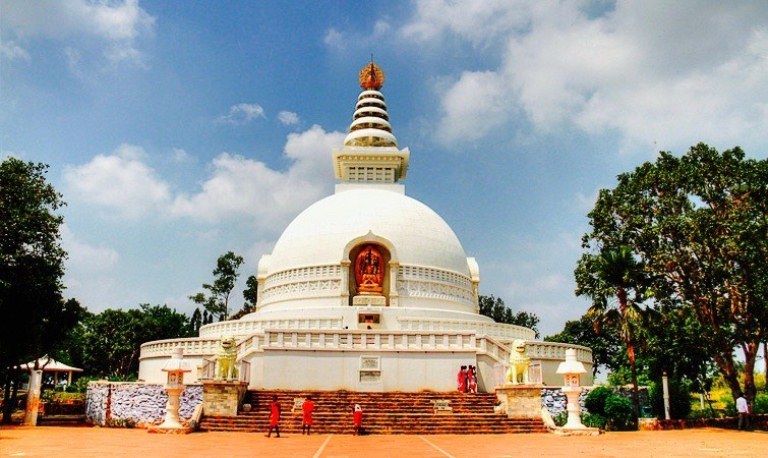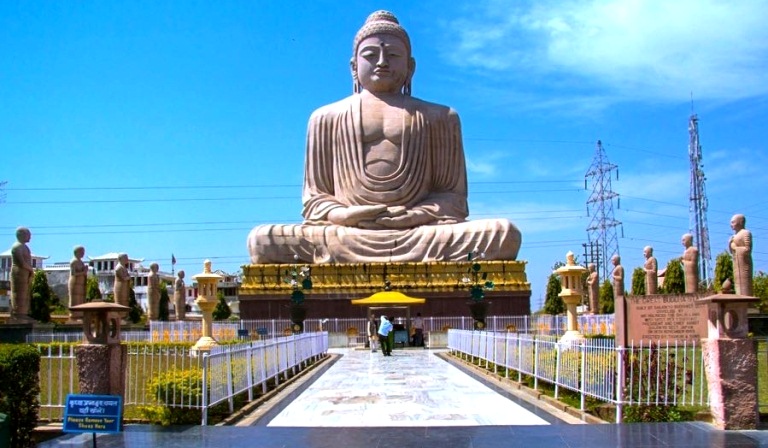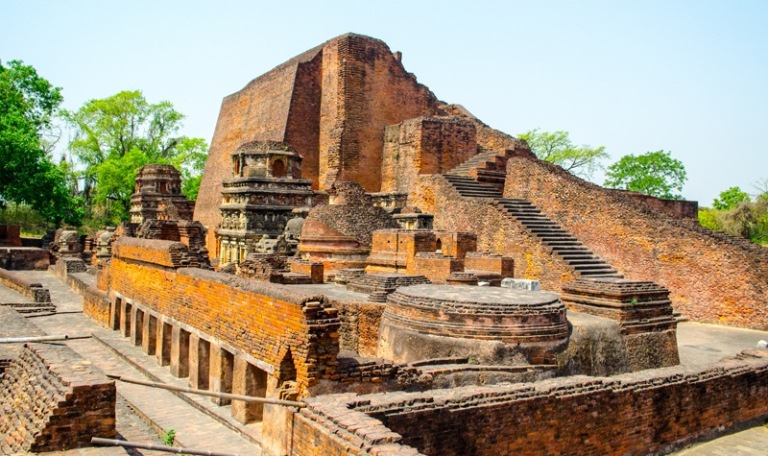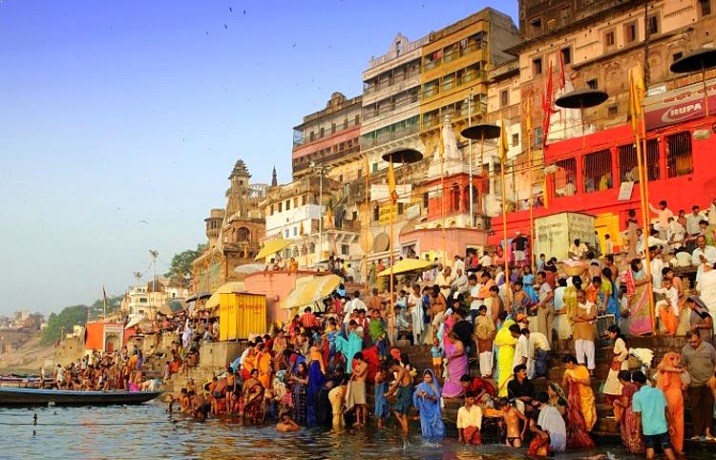
OVERVIEW- Buddhism is one of the most primitive and the largest religions of the world. This religion has been thrived in India from the 3rd century BC. Scores of Buddhist pilgrims come to India every year in quest of utter serenity offered by Buddhist destinations. These destinations are linked to the life and sermons of Buddha in a significant way. The land of the Buddha, India bridges the material world to the spiritual. Amazing Buddhist Tour covers the world-renowned holy site like Bodhgaya, Rajgir, Nalanda, Patna, Vaishali, Kushinagar, Varanasi and Sarnath. All the sacred sites have been associated with Lord Buddha right from his birth to the rise of Buddhism in India.
BODHGAYA- Gaya is the most symbolic city of Bihar. From being the birthplace of Buddhism to sharing deep bond with Hinduism and Jainism it is one of the major pilgrimage sites for Hindus and Buddhists. Its natural surroundings, narrow by lanes and its age old buildings make it special. Gaya is important for Buddhists as Buddha preached the Fire Sermon at Brahmayoni Hill, which was earlier called Gayasisa.
RAJGIR- Rajgir is town where the air that surrounds its beautiful sceneries carries hints of spirituality and vibrant hues of history with links with both Buddhism and Jainism. Set in a green valley and surrounded by rocky hills, Rajgir is a spiritual town with natural serenity amongst the dense forests, mysterious caves and springs. Both Lord Buddha and Lord Mahavir have said to spent time here giving Rajgir a huge spiritual and religious importance.
NALANDA- Nalanda is located in the eastern Indian state of Bihar. It is well known as the ancient centre of learning which has the remains of the great Nalanda University and several monasteries and temples. Both Lord Buddha and Mahavira visited this place and it remained a renowned learning centre till 12th century.
PATNA- Prospering along the southern banks of river Ganges and set in the conglomerated backdrop of rich ancient heritage and a glorious historical past, Patna boasts of a dominating presence in history and enjoys the distinction of being one of the oldest cities in the world. Originally called as Pataliputra, Patna is currently a hot-bed for the culminating political fortunes.
VAISHALI- Vaishali is deemed to be the embrace of people of two main religions of India which are Buddhism and Jainism. This place is supposed to be the oldest republic of the world. Vaishali is the birth place of Lord Mahavira, Lord Buddha preached his last sermon here and Emperor Ashoka erected a lion column to commemorate the occasion.
KUSHINAGAR- Nestled in the heart of Uttar Pradesh; Kushinagar is one of the ancient towns that attract people from all over for its beautiful Stupas and Temples. Kushinagar is a place where Lord Buddha attained Nirvana. It is famous for numerous monasteries and stupas dating back years ago are almost in relics now.
VARANASI- It is one of the oldest living cities in the world. It probably derives from the two rivers that flank the city, the Varuna to the north and the Asi to the south. Many still use the anglicized forms of Banaras or Benares, while pilgrims refer to Kashi. The city of Banaras is situated on the west bank of the holiest of all Indian rivers, the Ganga or Ganges. The relationship between the sacred river and the city is the essence of Varanasi - 'the land of sacred light'.
SARNATH- An ancient city, dating back to 528 BC, Sarnath is believed to be the first place where Lord Buddha started preaching and laid the foundation of Buddhism. It is one of the Buddhism's pilgrimage centers of India. Post attaining enlightenment, Buddha came to Sarnath where he gave his first sermon.
Tour Destination: Bodhgaya - Rajgir - Nalanda - Patna - Vaishali - Kushinagar - Varanasi
Travel Duration: 05 Nights/06 Days
DAY 1: BODHGAYA
Welcome at Gaya Airport / Railway Station. Transfer to the hotel. After breakfast, visit the holy city of Gaya.
MAHABODHI TEMPLE- The Mahabodhi temple is also called as the "Great Awakening Temple". It is among one of the World Heritage Sites. It is a Buddhist temple in Bodh Gaya, which marks the location where the Buddha, is said to have attained enlightenment. Mahabodhi temple is a historical place at which the Enlightenment of Gautam Buddha took place which later on became a place of pilgrimage.
BODHI TREE- The Bodhi Tree, is perhaps the most prominent and respected sacred places in Buddhism because of the rich historical significance attached to it. It is under this tree that Prince Siddhartha Gautama, the spiritual teacher who later became to be known as the Buddha, attained enlightenment. It is believed that Prince Siddhartha had to sit and meditate under this tree for seven days. Later on, a shrine known as Animisalocana Cetiya was erected on the spot where he had sat down. A small temple was also built near the Bodhi tree in the 7th century.
GREAT BUDDHA STATUE- This statue of Lord Buddha is the tallest in India and was instated by the XIV Dalai Lama in 1989. It is a meditating Buddha resting on a giant lotus, constructed using intricately carved sandstone and red granite.
THAI MONESTRY- Well known for its curved roof covered with exquisite tiles of gold, the Thai Monastery houses a bronze statue of Buddha and another recently erected 25m high statue in the garden.
ROYAL BHUTAN MONESTRY- The Royal Bhutan Monastery has been named so, as it was built by the King of Bhutan as a dedication to Lord Buddha. Clay carvings are seen on the interior walls of the monastery that depict different aspects of the Buddhist culture.
Overnight at Hotel.
DAY 2: BODHGAYA - RAJGIR - NALANDA - PATNA
Today morning go on an excursion to Rajgir and Nalanda.
JAPANESE PEACE STUPA- Also known as the Vishwa Shanti Stupa, this pillar is situated atop the Gridhakuta hill at an altitude of 400m. It was built as a symbol of world peace by the Japanese. This marble pillar also showcases four golden statues of Buddha depicting different stages of his life - birth, enlightenment, preaching and death. This location can be accessed by an aerial ropeway.
VULTURE'S PEAK- This was the place where the Lord Buddha set in motion his second wheel of Law and for three months every year during the rainy season, preached many inspiring sermons to his disciples. The Buddha Sangha of Japan has constructed a massive modern stupa, the Shanti Stupa (Peace Pagoda), at the top of the hill in commemoration.
BAMBOO GROVE- King Bimbisara donated the Bamboo Grove, Veluvana to Buddha for his residence. Today, it is a park with admiring sights of bamboos, flowers and a large pond with Buddha's image in the centre.
Further continue your drive to the beautiful city of Nalanda visiting
NALANDA UNIVERSITY- This University is one of the ancient heritage marvels of India that shaped the country's identity as the giver of the knowledge. Spread over an area of 14 hectares, the ruins here feature splendid temples and monasteries built by the patron kings.
NALANDA MUSEUM- Established in 1971, Nalanda Museum houses many ancient antiquities excavated from Nalanda University ruins and also at Rajgir. The antiques here feature many Buddhist and Hindu bronzes, a number of ancient Buddhist manuscripts, coins, pottery and inscriptions of Maurya and Gupta period.
SURYA MANDIR- Located near Nalanda University, Surya Mandir is dedicated to the Sun God and features a number of Hindu and Buddhist idols.
HUIEN TSANG MEMORIAL HALL- This memorial hall is dedicated to the historic Chinese traveller who came who left his home country in pursuit of Buddha and Buddhism to India in the 5th century AD and stayed in Nalanda for 12 years as a student. Also, he served the university as a teacher and studied the social and political conditions in the country. The memorial hall was built in his memory.
In the evening drive to Patna.
Overnight at Hotel.
DAY 3: PATNA - VAISHALI - KUSHINAGAR
Today drive to Kushinagar en route visiting Vaishali.
ASHOKA PILLAR- One of the renowned destinations of Vaishali located in proximity to coronation tank, Ashoka Pillar is a lion pillar constructed by King Ashoka. There is also a brick Stupa close to it which is believed to honor the last sermon of Lord Buddha.
BUDDHA STUPA 1- The exterior of this stupa which is now in a dilapidated condition has a plain surface. One-eighth of the sacred ashes of the Lord Buddha were enshrined here in a stone casket.
BUDDHA STUPA 2- Excavation at this site in 1958 led to the discovery of another casket containing the ashes of the Lord Buddha.
Further continue your journey to Kushinagar. Spend the rest of the day at leisure or you can go for a leisure walk around the place.
Overnight at Hotel.
DAY 4: KUSHINAGAR - VARANASI
After breakfast visit ancient town of Kushinagar.
PARINIRVANA STUPA- Excavated in 1867, Parinirvana Stupa is huge stupa made of brick. The stupa has Brahmi inscription on its walls and a reclining Nirvana statue of Buddha inside it.
RAMABHAR STUPA- It marks the place where Lord Buddha received the Mahaparinirvana or the Final Enlightenment. The 15 meters high stupa is one of the major attractions in Kushinagar.
MAHAPARINIRVANA TEMPLE- It is located in the ruins various ancient monasteries which were founded during the 5th century AD. The temple is famous for its 6.10 meters long statue of Lord Buddha. According to the inscriptions in the ruins, the remains of Lord Buddha have been deposited here.
Later in the evening drive to the city of Varanasi situated on the west bank of the holiest of all Indian rivers, the Ganga or Ganges. Transfer to hotel. Evening view “Aarti†ceremony on the Ghats.
Overnight at Hotel.
DAY 5: VARANASI - SARNATH - VARANASI
Today morning go on an excursion to the City of Enlightenment- Sarnath. Located 10kms East of Varanasi close to the confluence of rivers Ganges and Varuna, Sarnath is one of the major Buddhist pilgrimage sites in the world.
CHAUKANDI STUPA- The stupa is regarded as one of the most divine and important monuments of the Buddhist culture. This stupa has been built on the exact spot where the great Lord Buddha first met his five ascetics- to whom he later went on to preach his first teachings.
ASHOKA PILLAR- The national emblem of India and a mark of Emperor Ashoka's visit to Sarnath, the Ashoka Pillar crafted out of stone is an impressive structure with four lions at the top.
THAI TEMPLE- The temple displays the Thai style of architecture. The temple is set amongst beautiful gardens and is managed by Thai Buddhist Monks offering calm and peaceful surroundings.
TIBETAN TEMPLE- This Buddhist shrine has been decorated with Thangksa, which are Tibetan Buddhist paintings. The temple features a statue of Shakyamuni, the Buddha.
In the evening return back to Varanasi.
Overnight at Hotel.
DAY 6: VARANASI DEPARTURE
After breakfast, visit Varanasi viewing
KASHI VISHWANATH TEMPLE- Kashi Vishwanath, a manifestation of Lord Shiva, is the patron deity of Varanasi. The idol is a jyotirlinga, one of the 12 jyotirlingas in India. The Kashi Vishwanath temple has been built and re-built several times over the past few centuries. The present temple was built in the 18th century by Rani Ahalyabai Holkar of Indore after Mughal emperor Aurangzeb destroyed the previous temple and built a mosque at the site (now adjacent to it). The temple gets its name from Kashi, which is another name for Varanasi.
BANARAS HINDU UNIVERSITY- Banaras Hindu University is one of the largest universities in the world and a prime attraction in Varanasi. It was founded by Pandit Mohan Malviya in 1916 and is internationally reputed.
ASSI GHAT- Assi Ghat is the southern most ghat . It is located at the confluence of Ganga and Assi rivers. In the evenings, there is an aarti at Assi Ghat which attracts many tourists. Pilgrims bathe in the waters at the ghat before paying homage to Lord Shiva. It is the best place to witness Hindu culture and traditions as well as a beautiful sunrise.
DASHASHWAMEDH GHAT- Dashashwamedh Ghat is one of the oldest and most important ghats in Varanasi. In the early 16th century when the Marathas were ruling over the region, th3ey built several ghat sin Varanasi that lined the holy river Ganga.
In the evening depart at Varanasi Airport to catch flight towards onward destination.
Distance & Time (Approx)
- Bodhgaya - Rajgir - Nalanda - Patna: 200 kms/05 hrs
- Bodhgaya - Vaishali: 150 kms/05 hrs
- Vaishali - Kushinagar: 230 kms/07 hrs
- Kushinagar - Varanasi: 250 kms/06 hrs
Bodhgaya at a Glance
- Population: 470,839
- Area: 90.17 sq kms
- Geo Location: Bihar (North East India)
- Average Climate: 8°C - 30°C
- Best Time to Visit: October - March
- STD Code: 0631
- Airport: Gaya Airport
Rajgir at a Glance
- Population: 41,587
- Area: NA
- Geo Location: Bihar (North East India)
- Average Climate: 4°C - 26.5°C
- Best Time to Visit: October - March
- STD Code: 06112
Nalanda at a Glance
- Population: 2,872,523
- Area: 2367 sq km
- Geo Location: Bihar (North East India)
- Average Climate: 4°C - 28°C
- Best Time to Visit: November - February
- STD Code: 06112
Patna at a Glance
- Population: 20.5 Lakhs
- Area: 99.97 sq km
- Geo Location: Bihar (North East India)
- Average Climate: 15°C - 24°C
- Best Time to Visit: October - March
- STD Code: 0612
- Airport: Patna Airport
Varanasi at a Glance
- Population: 1,202,000
- Area: 82 sq km
- Geo Location: Uttar Pradesh (North India)
- Average Climate: 5°C - 20°C
- Best Time to Visit: October - March
- STD Code: 0542
- Airport: Varanasi International Airport
Need Aspark Help?
For Tour Packages, Vehicle Rental and Customer Care Support.
+91 9999 31 7846
booking@asparkholidays.comWhy Travel with Us?

Excellent Support
Our Team Available 24x7 for Customer support
Best Price & Savings
We Offer the Most Competitive Prices.



